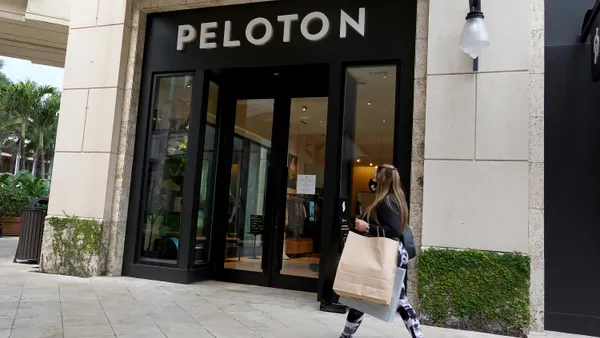Eleven years ago, Wal-Mart Stores President and CEO Lee Scott announced the beginning of Wal-Mart’s sustainability leadership.
Inspired by Wal-Mart's disaster relief efforts after Hurricane Katrina hit New Orleans just a month before — moments that showed "Wal-Mart at its best" — Scott laid out Wal-Mart's new sustainability plan in a presentation broadcasted to all Wal-Mart stores and distribution centers. Wal-Mart is in an advantageous position to respond to threats to the earth's environment, Scott said, just as it responded in New Orleans by leveraging its impressive distribution network to get critical supplies to those who needed them most.
"The environment is begging for [everyday low cost] ... for the Walmart business model. And if we do that, everyone will benefit," Scott said.
Scott laid out three broad sustainability goals for the company:
- Wal-Mart would be supplied 100% by renewable energy
- Wal-Mart would eliminate waste in its operations
- Wal-Mart would create more sustainable products for its customers
These objectives have since become the driving force behind Wal-Mart’s commitment to sustainability, pushing the company to not only look for efficiencies in its own operations, but also looking at its suppliers and distribution networks.
Fast-forward 11 years — Wal-Mart is now a sustainability leader in the retail sector.
It is the leading company in the U.S. for total on-site solar capacity and installations, topping both lists from the Solar Energy Industries Association, which include fellow retailers like Walgreens, Kohl’s, Target, and Apple. Currently, 25% of Wal-Mart’s operations are powered by renewable energy, including solar panels and wind turbines, with plans to double that number by 2020. Paired with Wal-Mart’s goal to cut energy consumption in stores by 20%, the retailer estimates it will save $1 billion a year thanks to these initiatives.
Wal-Mart has also reduced plastic bag waste from its stores by more than 38% since 2005, and has diverted 81% of materials from its U.S. stores and distribution centers from landfills. In fiscal 2016, Wal-Mart reduced its CO2 emissions by nearly 650,000 metric tons by doubling the efficiency of its fulfillment operations.
These are impressive figures, to be sure. But while Wal-Mart leads many U.S. retailers with its sustainability efforts, it remains relatively quiet about them, especially when compared to the green, environmentally-friendly branding of retailers like Patagonia, REI, or Whole Foods. Wal-Mart primarily lets the numbers do the talking, painting its sustainability efforts as more of a business choice than a move fueled by concern over climate change and global warming.
This might strike some as a missed opportunity — Wal-Mart essentially passing on a way to attract a more diverse consumer base and bring itself positive press. But experts tell Retail Dive that this is likely a calculated move, one the company uses to avoid judgment from critics and customers alike.
“On the scale of what needs to be done for sustainability, no company or few companies can do it all. The minute that you start saying ‘hey look at me!’ you invite people to hey, look at you, and they'll find something that you’re doing that does not align with that,” Allen Adamson, founder of Brand Simple Consulting, told Retail Dive. “Since you often can’t change everything, the prevailing conventional wisdom in marketing and sustainability is ‘do more, talk less.’”
How Wal-Mart thinks about sustainability
When thinking about what drives Wal-Mart’s sustainability efforts, it helps to examine the language the retailer uses to introduce such initiatives to customers, shareholders, and employees. While Wal-Mart leads retail in its progressive energy sourcing, it's clear from the language used to describe these measures that these decisions are driven by the money saved by the company — savings the company can pass onto its customers.
"Our work to achieve these goals and reduce our environmental impact, like any other project, must also move the needle from a business bottom line perspective — this is essential in order to support our long-term sustainability work," Wal-Mart spokesperson Kevin Gardner told Retail Dive in an email. Wal-Mart declined to elaborate further on why its sustainability branding is focused primarily on business and less on the environment, offering only past statements.
Retail Dive conducted a search of the past five Wal-Mart Global Responsibility Reports, which span a total of 780 pages, keying in 18 common business and environmental words or phrases. The winner, by far, is “business,” mentioned a whopping 881 times across all five reports. Second is “customer,” with 747 shout-outs, followed by “sustainability” (645) and “responsible” (176). Mentions of saving money (low cost, savings, low prices, save money) occur 126 times, while mentions of the most common environmental phrases, such as “climate change,” “global warming” and “planet,” fall in the single or double digits.
| Word | Total mentions in Wal-Mart Global Responsibility Report, 2012-2016 |
|---|---|
| Business | 881 |
| Customer | 747 |
| Sustainability | 645 |
| Responsible | 176 |
| Greenhouse gas | 84 |
| Savings | 73 |
| Planet | 57 |
| Low Prices | 29 |
| Climate change | 23 |
| Save Money | 16 |
| Low cost | 12 |
| Generations to come | 5 |
| Global warming (outside of GWP) | 5 |
| Shopper | 5 |
| Earth | 4 |
| Future generations | 2 |
Wal-Mart, of course, is not alone in this practice. Rival retailer Target also frames its sustainability efforts in this careful way, touting the retailer’s commitment to its “business” and “guest” more than any of the 18 other phrases in its 45-page 2015 Corporate Social Responsibility Report. Apple also mentions "business" 19 times in the 50 pages of its 2016 Environmental Responsibility Report, although "climate change" gets second place, being cited 10 times.
But when comparing Target and Apple's corporate sustainability webpages to Wal-Mart’s, the companies' branding stands in stark contrast. Target takes a community-focused approach, choosing to spotlight its commitment to “vibrant” and “healthy” communities. Apple leads with "innovation," the "environment" and its "carbon footprint." Wal-Mart, in contrast, is all business.
“Environmental sustainability has become an essential ingredient to doing business responsibly and successfully…our actions have the potential to save our customers money and help ensure a better world for generations to come,” the top line on Wal-Mart’s sustainability website reads. “At the same time, it sets the stage for a more financially stable and responsible Walmart.”
Wal-Mart has reiterated this statement in past press about the company's broader corporate responsibility actions, including raising the minimum wage for employees and focusing on the welfare of animals in its supply chain.
"These are first and foremost business decisions," Wal-Mart Spokesperson Molly Blakeman told Adweek, when asked if it they were part of an effort to improve the company's brand perception.
In these statements and reports detailing its commitment to sustainability, Wal-Mart strives to make the reason for its sustainability leadership very clear: it’s best for business. And what’s best for the business is best for the customer, Wal-Mart argues, as it passes on cost savings through everyday low prices.
But the question remains: why does Wal-Mart pass on touting its sustainability efforts more assertively, especially when there is a major demographic of environmentally-conscious consumers it could capture by doing so?
The silent defense
Wal-Mart's type of careful branding is often intentional, experts say — a defensive strategy many large companies take. In the past, retailers have found that advertising their sustainability efforts invites criticism; rather than focus on the positive steps companies take, many critics focus on all the steps they are not taking — or have yet to take — to become more eco-friendly.
“I know many big retailers that are doing the right thing but they continue to be eaten alive by very powerful and vocal activists,” Marci Zaroff, a sustainability consultant for retailers like Target and Bed, Bath & Beyond, told Retail Dive.
Some chalk this up to the increased power the internet has given customers, especially digitally-savvy and environmentally-friendly millennials.
“It used to be that you can just make a claim in an ad and make people feel good on one side of the company while on the other side, you could do whatever you want,” Adamson says. “But now [retailers] are going to get called out. Now, if [customers] see something sustainable on the energy front but terrible on another front, [retailers] are going to run into trouble.”
Wal-Mart is no stranger to criticism. In the past 12 months alone, Wal-Mart has seen strikes at China Wal-Mart stores, protests in Chicago in support of the Responsible Business Act, which would require businesses to provide employees a living wage, and a report from the Associated Press saying that Wal-Mart sold shrimp linked to human trafficking in Thailand. Inviting more criticism — even if it stems from net positive press about its sustainability efforts — may not be worth the trouble for Wal-Mart.
Experts say that Wal-Mart has chosen not to overtly brand itself as a “green” company mainly because its target customer is not concerned about environmental issues like those who shop at, say, Whole Foods and Patagonia. Given Wal-Mart’s vast resources, experts say that it’s likely the company has tested a more “green” marketing strategy with its typical customer — white, low-to-middle income Baby Boomers. The fact that the company's sustainability leadership isn’t more prominent in Wal-Mart’s branding is very likely a sign that the customer didn’t care.
A push to more green branding could even turn customers off, as using the word “sustainability” can lead customers to expect a more costly product.
“For many consumers, saying you are a sustainable company often translates into ‘oh they're going to be more expensive now,’” Adamson said. Wal-Mart has “to be very laser focused on a very simple message: save money, live better.”
More 'green' to come?
While Wal-Mart’s simple branding may benefit the retailer in the short term, experts warn that a new generation of consumers may prompt the company to ratchet up its green marketing.
As millennials enter their prime spending years, they are ushering in a new perspective to buying, one that, like their perspectives on climate change in general, skews green. A 2014 Nielsen survey found that millennials make up 51% of all people who base their purchasing decisions on a brand’s sustainability actions, while 55% of all consumers would pay more for products from brands with a sustainable impact — a growing number, up 10% from just three years earlier.
These stats — and the increasing number of consumers that care about brands’ sustainability efforts — may force Wal-Mart's sustainability efforts into the spotlight. But there are tangible steps that Wal-Mart and other retailers can take to avoid being eaten alive when they choose to market their efforts more prominently, according to Zaroff, Adamson, and Adam Siegel, vice president of sustainability and retail operations at the Retail Industry Leaders Association.
While a company’s sustainability efforts will take time to produce big results, retailers should be clear about their progress, setting up realistic goals and reporting them every year — as Wal-Mart does with its Global Responsibility Report. Seeking help from NGOs and advocacy groups when establishing these goals will not only bring other points of view into the equation, but they may also help alert retailers of actions that they didn’t even think of taking at first, helping bridge the gap between corporations and activists. These goals will not only help on the publicity front, but also internally, giving every part of the company a sense of accountability and teamwork to accomplish the goals.
“It's always about raising the bar,” Zaroff said. “As long as you’re transparent and being proactive and volunteering what you need to work on, that comes from a better place. The companies that are setting goals and giving dates where they want to be, clear strategy and clear roadmaps … Those are the retailers that are in a better position to communicate what they're doing.”
Once retailers have set up this framework, then it's time to engage customers, experts told Retail Dive. This includes anything from promoting more “green” products that are sustainably sourced, or advertising their eco-friendly buildings in a more inventive way. The most important piece to consider is engaging the customer — making sometimes complicated (or even boring) energy and waste efforts more accessible and appealing.
But even if Wal-Mart chooses to stay relatively quiet about its sustainability efforts and focus on the bottom line, they are still working toward the three goals Scott laid out onstage in Bentonville, Arkansas, 11 years ago.
"Many are just trying to work it out and its a moving target," Zaroff said. "The encouraging thing is most of the major retailers are on the train now. They don't know where they're going, but they're on the train."













